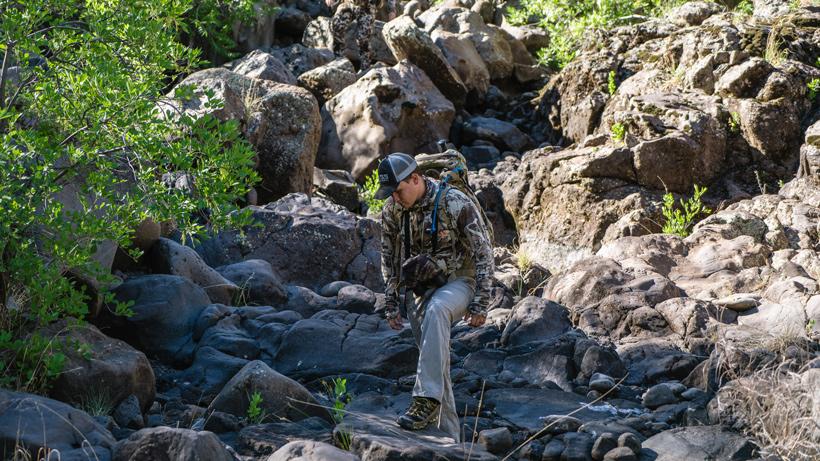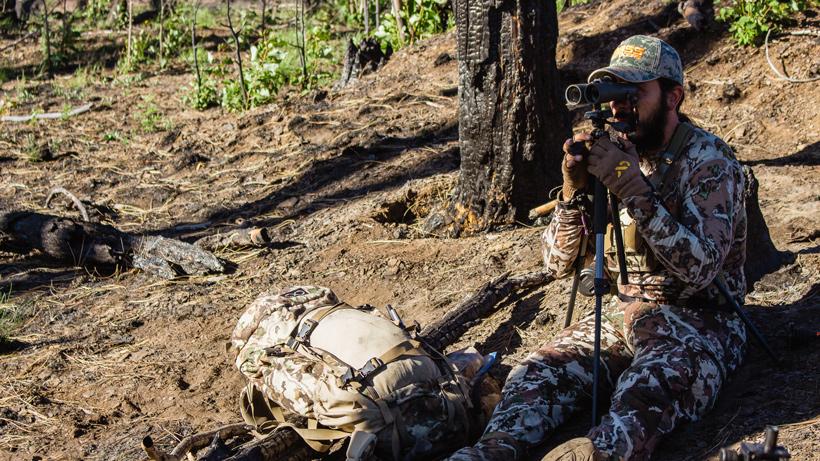











When I first heard the term "layering system," I wrote it off as a bunch of mumbo-jumbo. I was perfectly content with my huge stack of long johns, flannels, and hand-me-down jackets. To me, it was just another ploy to get the attention of hunters who had a wallet too big to sit on. Over time, though, I did start to get tired of bringing a suitcase full of clothes with me on my hunts. Wearing too many clothes also interfered with my mobility, which wasn’t cool—especially if you are a bowhunter. I used to wear the leg end of a sock on my arm and over my jacket so that my bow string wouldn't make contact on the shot. If it did, my arrow would fly left. So, this layering system mumbo jumbo started to get my attention. I noticed that the clothing was not nearly as bulky and you didn't need nearly as much of it. Now, the problem was, where to start?
The best place to start is to, first, define what a layering system actually is. The term gets thrown around a lot, especially now with all of the new high tech clothing lines out there. When I started looking into this stuff, it was pretty confusing to me. Each company might have their own names for certain pieces of clothing, which is, of course, not universal throughout the rest of the industry. This can be confusing if you are not educated on the subject. However, a layering system is exactly what it says it is: a system that works together to cover you all the way from blazing hot temperatures to freezing ones. Sounds hard to believe, right? Believe me, I know, because I was there. What if I told you that I have three to four pieces of gear that get me through 95% of the year? That's way less than the stack of clothing I once used. It's also way more efficient and effective. Here's how it works.
Your first and second layers are going to be your base layers. Some might see these and think that they are reminiscent of the long johns we are all familiar with from our youth. They might resemble them in appearance, but they are very different. Unlike the old school long johns that were only worn in cold weather, these new pieces are also worn in hot weather. I wear the same base layers whether it is 100 degrees or 20 degrees. Sounds impossible, right? How does something keep me both warm and cool when I need it to? The key is in the fabric being used. These technologically advanced fabrics are made to breathe extremely well, which will keep you cool when it's hot and wick moisture away from your skin, which will help keep you warm when it's cold. These layers are made out of two main fabrics: merino wool and synthetic.
Merino wool is my preferred fabric for base layers. In order to understand why you really just need to try the stuff out. I first started looking at merino wool specifically for backpack hunting. Why? Well, on backcountry hunts you don't really have the luxury of bringing that suitcase full of clothing. This is where merino wool comes in. Merino wool is naturally odor resistant. This is because bacteria have a hard time latching onto its super fine threads. Because of this, you can wear these pieces for long periods of time with a very minimal stink factor. I say minimal because, after 10 days in the field, you yourself will stink, but the stink on the clothing will be very minimal, if not non-existent altogether. Another benefit to merino wool is it retains 80% of its insulation value—even when it is soaking wet. This is a major help when you are either sweating your tail off or get hit with an unexpected downpour. The only downside I have found with merino wool is that it is not the most durable of fabrics. If you want that, then you need to pick synthetic.
Synthetics or polyester also make a great base layer. Layers made of this material are going to be comfortable and will dry very fast—much quicker than merino wool. As I have already pointed out above, these fabrics are also more durable than merino wool. Before using merino wool, I dabbled in the world of synthetic. Right off of the bat, I was impressed. I loved how the material felt on my skin and wondered why I didn't try this stuff out before. But what’s the downside of synthetic? I found that out after only one evening of glassing during a summer month here in Arizona. A pungent smell kept wafting across my nose out there. My first thought was, "Man, my hunting partner must have forgotten to take a shower or something." But I was wrong. I was actually smelling myself. The stink factor of synthetics is pretty high. If you are just day hunting from the truck, give this stuff a try. However, if you are planning on heading into the backcountry, I would stick with merino wool.
Believe it or not, it does get cold here in Arizona from time to time so I need a good insulation layer to add to my system. We've discussed base layers and how they move moisture away from your skin. An insulation layer is going to not only insulate your body heat, but it is going to help dry out those base layers underneath as they wick that moisture away. Remember, I said this stuff all works together. Insulating layers are going to vary slightly in terms of fabric, but the end goal is the same: it will keep you warm! A lot of jackets will be made of down. Down is super warm, super compressible, and super lightweight. This really comes in handy when you are stuffing that jacket into your pack for the day. It weighs little to nothing and takes up a minimal amount of space in your pack. Other jackets are made of a synthetic blend of sorts. Unlike the stink factor differences I have found in the base layers, I haven't noticed that with the jackets. Some insulation layers also have a DWR coating applied to the outside of them in order to help keep you dry should you get hit with some rain. This is no substitute for actual rain gear but can help in a pinch. That brings me to the next thing on our list: rain gear.
The first year I ever went bear hunting, my hunt was "ruined" by rain. I ended up going home early because I simply was not prepared for the weather. I vowed from that point on that I would have rain gear so I didn't have a repeat of that first year. Fast forward to now and I'll tell you this: My rain gear layer drifts its way in and out of my pack. I really just go by the weather report. If there is rain in the forecast, it comes with me. If not, I leave it at the truck. While the insulation layer is basically like your mobile sleeping bag, your rain gear is like your mobile tent. If I am on a backpack hunt, I usually always bring rain gear with me. Especially during the months of August and September when monsoons can pop up out of nowhere; I like to be prepared for those. Some folks complain about the noise that comes with having rain gear, but, in my opinion, this is not really important. When it is raining, there is already noise from the rain so that's not really a concern I have with it. Another concern that many have with rain gear is breathability. This is a valid concern, but I think you can only go so far with this. It makes sense that breathability is limited because it is a hard shell piece. It is made to keep water out, but that also means that it will keep water in. At this moment, it is a necessary evil.
As far as downstairs goes, I keep it pretty simple. For underwear, I'll use a light/midweight merino wool boxer short for the same reasons I use the tops. If it is really cold I will throw on a midweight full-length merino base layer over those followed by my pants. For pants, you can go with either a merino wool pant or synthetic—much like the options for tops. Synthetic is going to be more durable, but also a tad noisier. This could pose a problem when spot and stalking animals with a bow. For that, my favorite pant is a merino wool pant. Not only is it comfortable, but they are dead quiet and perfect for sneaking up on an unaware buck. I use both types of pants and each of them has their place in my system. When it comes to socks, I prefer a merino wool sock. I can wear these for days on end and they are extremely comfortable. I have yet to get a blister wearing these.
Here is my basic layering system that gets me through 95% of the year. I say 95% because there might be a time later in the season where I add an extra layer of clothing up top, which will usually be a fleece type layer for added warmth.
If you were like me and are sitting on the fence with this stuff, I hope this article points you in the right direction. Layering systems might differ slightly from climate to climate, but the foundation remains. Nowadays, having a layering system is an absolute must for me and, truth be told, I won't do it any other way. Since I have changed my ways, I have never been more comfortable out in the field. Because of that, I find myself spending way more time in the field—no matter the conditions. This transfers into more animals spotted, which inevitably leads to more opportunities to fill that tag.
First Lite Wick (lightweight base layer)
First Lite Kiln (midweight base layer)
First Lite Uncompahgre Puffy (insulation)
First Lite Vapor Stormlight (rain gear)
First Lite Red Desert Boxers
First Lite Corrugate Guide Pants (nylon) or First Lite Obsidians (merino wool)
First Lite Boundary Stormtight (rain gear)
First Lite Mountain Compression Socks